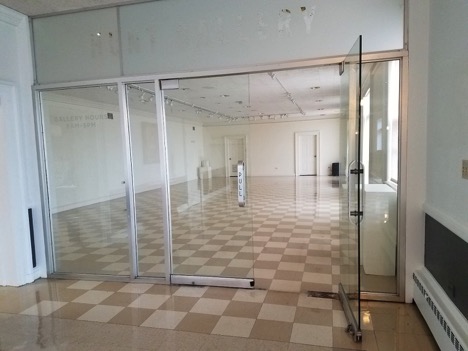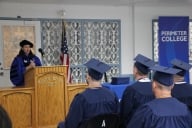You have /5 articles left.
Sign up for a free account or log in.
Mary Baldwin University last week shut down an art exhibit after some students said that the art was racist. The artists involved say their art wasn't racist at all -- but has been misunderstood.
The exhibit, "RELEVANT / SCRAP," is about the monuments, common in much of the South, to Confederate heroes. The two artists are white people who grew up in the South, and they say that the exhibit reflects their awareness that these monuments -- glorified by some -- are deeply hurtful to others and contribute to distortions of U.S. history. The art features images from statutes, turned into other images and mixed with other materials.
The current debates about such monuments, combined with "the current post-truth context in the U.S." add to the "complexity of the issue," the artists wrote in a document explaining the exhibit. (Three images from the exhibit are above.) The monuments that are the focus of the art are from Monument Avenue in Richmond, which includes statues of numerous Confederate heroes.
An anonymous group called Concerned Students of Mary Baldwin circulated an email calling the exhibit racist, and student leaders endorsed that view.
 Mary Baldwin then held a forum for students, who again called the exhibit racist, and the university then took all the art down. A statement from the university said, "In accordance with our values as an inclusive, student-centered campus community, we take seriously the concerns about an art exhibition by two Richmond-based artists installed earlier this week in Hunt Gallery. As a result of student concerns and discussions with the artists, the installation has been removed as of last night." The statement was illustrated with an image of the empty gallery.
Mary Baldwin then held a forum for students, who again called the exhibit racist, and the university then took all the art down. A statement from the university said, "In accordance with our values as an inclusive, student-centered campus community, we take seriously the concerns about an art exhibition by two Richmond-based artists installed earlier this week in Hunt Gallery. As a result of student concerns and discussions with the artists, the installation has been removed as of last night." The statement was illustrated with an image of the empty gallery.
The statement added that the exhibit had been booked three years ago, before the art was created. "Moving forward, Mary Baldwin will review its policies and procedures for selecting and booking cultural exhibitions on campus, including facilitating student input," the statement said.
The artists -- Jere Williams and Pam Sutherland -- released a statement in which they said that they agreed that the art should have been removed. But they said that their work had not been understood.
"We assure you that we are neither in agreement with the ideology of the Lost Cause nor racist (as many of the students called us)," they wrote. "Our intention with this work is to use art making processes to create an aesthetic experience of the problematic challenge of reimagining the spaces where the monuments to the Confederacy currently reside in Richmond."
Their statement expressed regret not about their art but about the lack of understanding of it.
"One mistake that we made was being naïve in the assumption that viewers reading our statement and viewing the work would understand our position on both the nature of the monuments to the Confederacy and our constructive intentions," the artists said. "We wholeheartedly believe the Civil War was fought over slavery, that these monuments were installed to foster oppression and that they ought not remain installed exactly as they as are because they don’t represent what we value. In hindsight, it might have helped if we discussed this background information rather than quickly delving into an art process discussion as we did. As such, we seem to have been misunderstood as people, and in our estimation the presence of the work does not violate the safe embrace of shared experiences or differences as stated in the university’s inclusivity statement."
This is not the first time that artwork on a college campus about racism has been criticized as racist. Salem State University shut down an exhibit featuring works inspired by the 2016 election when students complained about work that featured an image of Ku Klux Klan members. The artist said he was drawing attention to similarities in the hate spewed by the Klan and President Trump, but students urged that the exhibit be closed. Salem State subsequently reopened the exhibit, but with curtains and a warning that would be seen before encountering the work that caused offense.
Jonathan Friedman, the project director for campus free speech at PEN America, said via email that he was concerned about what happened at Mary Baldwin.
"In the midst of a rise in hate crimes, and important national questions about the legacies of slavery and the Confederacy, students' reactions to the exhibit's content are understandable, and could have been better anticipated when the work was first revealed," he said. Further, he said that Mary Baldwin's "decision to host a listening session with students is the right idea; but they could have done so while also staunchly defending the artists' rights and the value of free expression. Engagement ahead of time to prepare the campus for the exhibit and hear from the artists about their creative process and aspirations might have helped to avert this regrettable result."
Friedman added, "Once the works were put up on display the decision to withdraw them puts the viewpoint of protesters above those of the artists who created the exhibit, the curators who developed it, and the audiences who may have wished to view it. Teaching students that censorship is the solution to provocative material is a dangerous lesson, one which should be of grave concern to the artistic and academic communities alike. It not only goes against the spirit of hallowed artistic traditions, but also creates a wide opening for others to call for censorship in universities and museums in response to content that provokes or offends, no matter the grounds."








